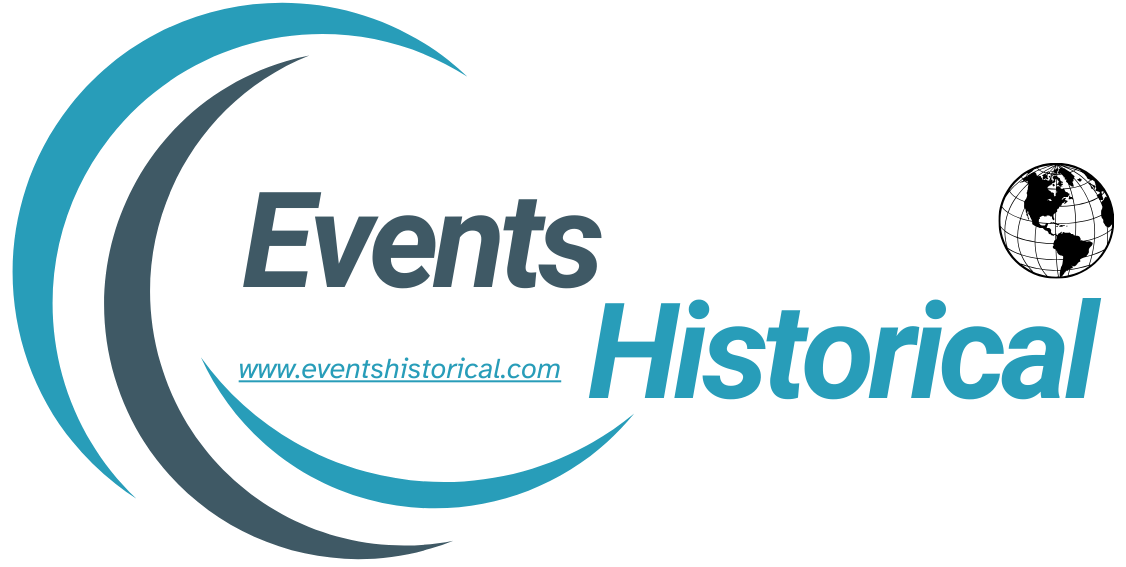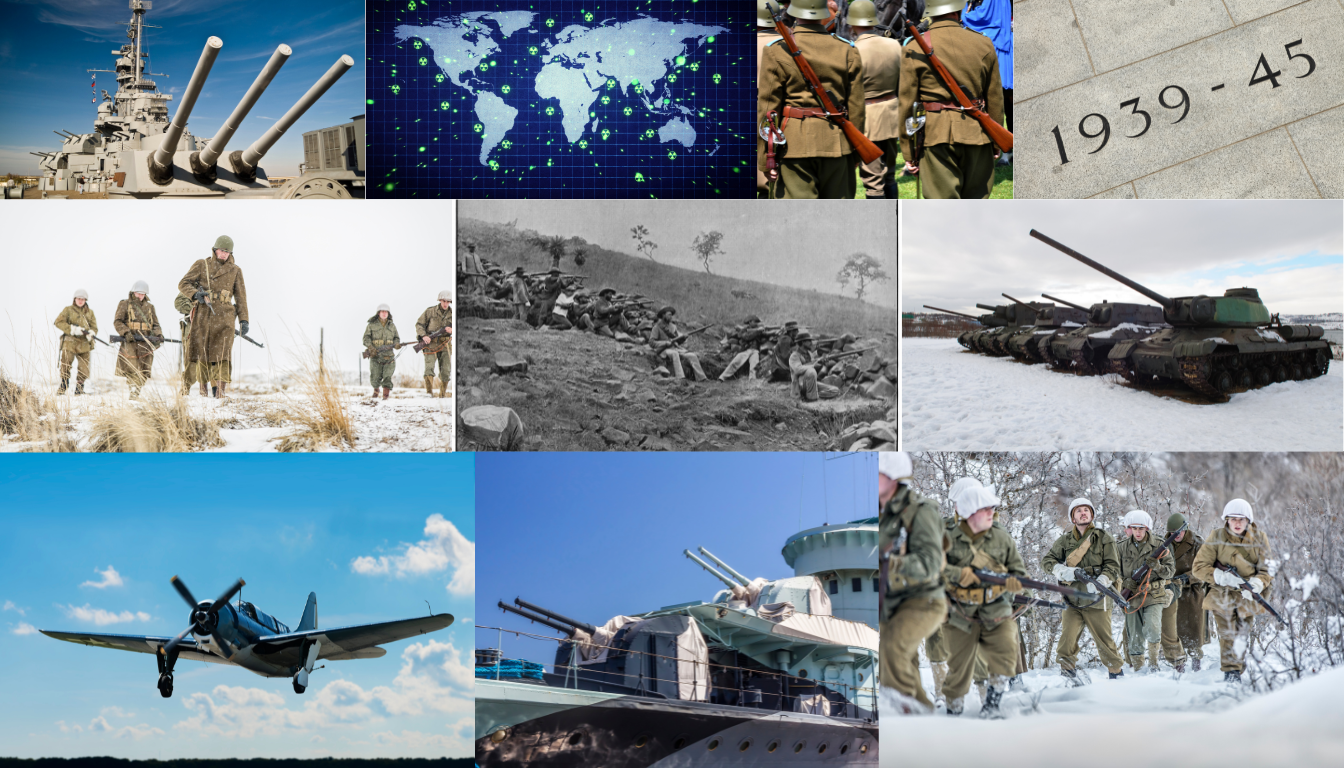Explore the profound impact and enduring legacy of World War II: The Second Global Conflict (1939-1945) in this comprehensive overview.
How did World War II change the world? This deep dive into the Second Global Conflict explores the devastating years from 1939 to 1945. It’s more than just a war between big powers. It’s a story of a world fighting for its future, with both horrors and heroics that changed history.

Let’s explore the complex reasons behind this war. We’ll see it through the eyes of those who lived it and the decisions that ended it. Despite being the deadliest war, its impact goes beyond the battlefield. It shaped our modern world and sparked changes that still echo today.
Key Takeaways
- Early in 1941, countries like Hungary, Romania, and Bulgaria joined the Axis powers.
- The Holocaust, with around 4 million Jews killed in Polish death camps, was a dark chapter in history.
- The Battle of Midway in June 1942 was a turning point in the Pacific.
- The attack on Pearl Harbor on December 7, 1941, drew the United States into the war, killing over 2,300 troops.
- D-Day, on June 1944, saw the Allies break through Nazi-occupied Europe at Normandy’s beaches.
- The Soviet Union won a major victory as German forces surrendered in Stalingrad by January 1943.
- Germany surrendered on May 8, 1945, and Japan followed soon after, ending WWII. But the war’s impact on the world and society was lasting.
The Prelude to Global War: Unresolved Issues from WWI
The years before World War II were filled with problems left over from World War I. The Versailles Treaty, meant to bring peace, actually set the stage for more war. It was too harsh on Germany, causing economic troubles and the rise of extreme groups like fascism and Nazism.
Adolf Hitler became powerful because of these issues. He used the anger and frustration to push for more land and power.
The Versailles Treaty and the Rise of Fascism
The Versailles Treaty was made in 1919 to stop wars. But it made things worse in Europe. It forced Germany to pay a lot of money and give up land, hurting their economy and pride.
This made people angry, and Hitler used that anger to grow his fascist movement. The League of Nations failed to enforce the treaty, letting Hitler and others act aggressively.
Hitler’s Expansionist Agenda and the Failure of Appeasement
Hitler broke the Versailles Treaty in many ways, like building up his army and taking land. He took Austria and parts of Czechoslovakia, saying it was for ethnic unity. But really, it was to make Germany bigger.
European leaders tried to stop him with appeasement, but it didn’t work. This let Hitler keep going, leading to a big war in Europe.

| Year | Event | Impact |
|---|---|---|
| 1919 | Establishment of the Versailles Treaty | Imposed severe reparations and territorial losses on Germany |
| 1933 | Adolf Hitler becomes Chancellor of Germany | Start of fascist policies and suppression of civil liberties |
| 1938 | Annexation of Austria and Sudetenland | Major territorial expansions without significant opposition |
| 1939 | Failure of appeasement at Munich | Embodied the ineffectiveness of European diplomatic efforts to prevent war |
Invasion and Response: The Outbreak of World War II
The start of World War II was marked by key events and alliances. The German-Soviet Nonaggression Pact of August 23–24, 1939, was a major turning point. It allowed Germany to attack Poland without fear of Soviet interference.
This Pact was a direct cause of the 1939 invasion of Poland by Nazi Germany. It made it clear that war was coming.
The German-Soviet Nonaggression Pact: A Catalyst for War
The Pact was signed in secret. It was an agreement between Germany and the Soviet Union not to go to war. But it also had secret parts that divided Eastern Europe into areas for each country.
With no fear of the Soviet Union, Germany felt free to expand its territory. It started with Poland. Just days later, on September 1, 1939, Germany invaded Poland. This marked a big step towards a global war.
Poland Overrun: Britain and France Declare War
Poland was quickly overwhelmed by German and Soviet forces. But it was the boldness of Germany’s move that finally got a reaction from the Allied powers. Poland couldn’t fight off both Germany and the Soviet Union.
So, Britain and France declared war on Germany on September 3, 1939. This was the start of the Second World War for major world powers.
The early days of the war had big effects. Here’s a table with important dates and figures from the start of World War II. It shows who was involved and how the world reacted.
| Date | Event | Key Participants |
|---|---|---|
| August 23–24, 1939 | Signing of the German-Soviet Nonaggression Pact | Germany, Soviet Union |
| September 1, 1939 | Invasion of Poland by Germany | Germany, Poland |
| September 3, 1939 | Declaration of War by Britain and France on Germany | Great Britain, France, Germany |

Axis Powers Ascendant: Early Victories and Expansions
At the start of World War II, Germany, Italy, and Japan made big moves. They won early battles that changed the game in Europe and Asia. Their quick wins and smart strategies were key to their early success.
Blitzkrieg Tactics and the Fall of France
Germany used Blitzkrieg, or ‘lightning war’, to great effect. It was a fast, coordinated attack with tanks and planes. This method quickly broke through enemy lines.
In just six weeks, Germany beat France and its allies. This led to a quick armistice. Germany then controlled much of Western Europe.
Operation Barbarossa: The Turn Towards the Soviet Union
After winning in the West, Hitler turned to the Soviet Union with Operation Barbarossa. It was the biggest invasion ever. Hitler wanted to defeat the Soviet Union and grab its resources.
Germany did well at first, gaining land. But, this war wore them down. It was a long fight that would eventually lead to their defeat.
The table below shows how the Axis powers grew through their early alliances and conquests:
| Event | Date | Details |
|---|---|---|
| Axis Pact Formed | October 25, 1936 | Germany and Italy formalize their alliance. |
| Anti-Comintern Pact | November 25, 1936 | Germany and Japan unite against the Soviet Union. |
| Pact of Steel | May 22, 1939 | Full military and political alliance between Germany and Italy. |
| Tripartite Pact Signed | September 27, 1940 | Germany, Italy, and Japan solidify their alliance against the Allied powers. |
| Operation Barbarossa Initiated | June 22, 1941 | The massive invasion of the Soviet Union begins. |

Strategic Alliances: Shifting Dynamics in Global Power
During WWII, alliances were key in the global conflict and its outcome. The Allied and Axis Powers’ dynamics shaped the war and the world’s politics. The United States, United Kingdom, and Soviet Union fought against Germany, Italy, and Japan.

These alliances formed through important agreements and conferences. The Declaration by United Nations in 1942 showed the Allies’ unity against the Axis. The Tehran and Yalta Conferences were crucial, reshaping borders and governance.
The Allies combined military and political strategies. This ensured a strong fight against the Axis. The Douglas C-47 Skytrain was a key example of this cooperation, helping in major operations.
- Roosevelt, Churchill, and Stalin only met twice, yet these meetings were crucial in aligning strategy and post-war plans.
- The shifting dynamics post-Roosevelt’s death in 1945 marked the beginning of altered relationships leading up to the Cold War.
The United Nations was formed in 1945, showing alliances’ shift to peace efforts. The Allies became global leaders, influencing policy and economics.
In conclusion, WWII alliances were more than just a response to the Axis. They led to a new global order, marked by the Cold War. This era was shaped by WWII’s experiences and outcomes.
The Pacific Theatre: Japan’s Expansionist Military Campaigns
In the early 20th century, Japan’s aggression grew, leading to the Pacific Theatre’s conflicts in World War II. Japan wanted to control East Asia, causing wars with neighbors and the Allies. Key battles at Pearl Harbor, Midway, and Guadalcanal were turning points in the war.
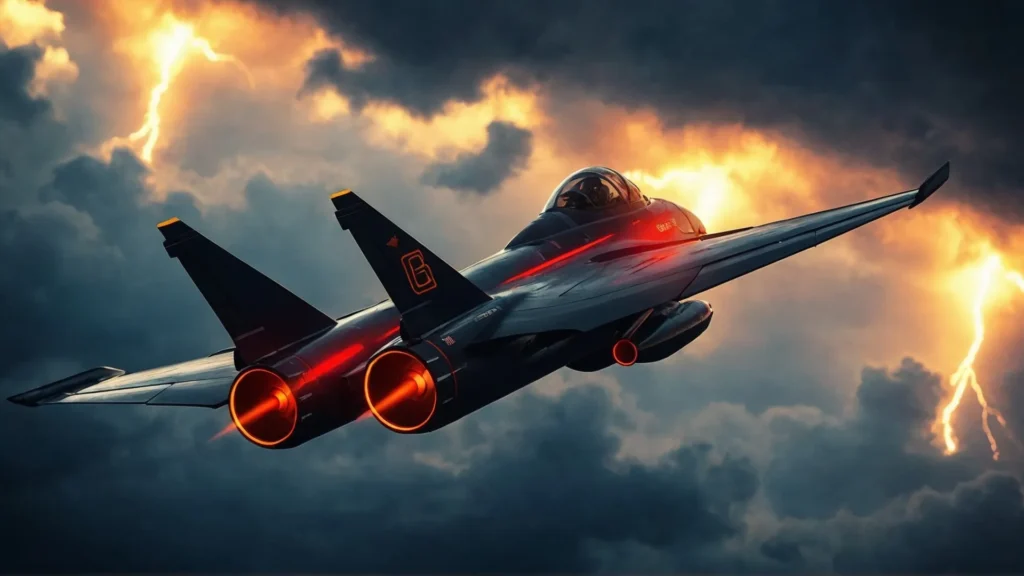
The Japanese launched a surprise attack on Pearl Harbor on December 7, 1941. This attack killed 2,403 Americans and drew the United States into World War II. It was a major moment in the Pacific Theatre.
The Path to Pearl Harbor: Prelude to American Engagement
Japan’s need for resources, cut off by an American oil embargo, drove its aggression. Losing 80% of its oil, Japan sought to expand in the Pacific. The attack was a strategic move to get resources and prevent American response.
Midway and Guadalcanal: Turning the Tide in the Pacific
The Battle of Midway in June 1942 was a big win for the United States. Japan lost four aircraft carriers, a cruiser, and over 300 planes. This defeat weakened Japan’s power and gave the Allies the upper hand.
The Guadalcanal campaign, starting in August 1942, showed the Pacific’s brutal fighting. It was part of the Allies’ strategy to take key islands. This campaign weakened Japan’s resources and morale, helping the Allies.
These battles were crucial in stopping Japan’s expansion and turning the war’s tide. The victories at Midway and Guadalcanal were key moments in the Pacific Theatre during World War II.
America’s War Effort: Mobilization and Military Strategy
The American military’s response to World War II showed the true meaning of total war. Every part of the country worked together to support the war. This effort was massive, with huge resources used to build a strong military for complex strategies.
About 16,112,566 Americans joined the armed forces, showing the huge scale of U.S. mobilization. The military’s impact went beyond numbers. It involved both combat and support roles, crucial for Allied success.
The war cost the U.S. $296 billion in 1945 dollars. This shows the huge amount of money spent on the military. By the end of the war, military spending was 38% of the national GDP. This highlights how deeply war affected the economy and society.
| Statistic | Figure |
|---|---|
| Total U.S. Service Members | 16,112,566 |
| War Casualties (Killed) | 291,557 |
| War Casualties (Wounded) | 671,278 |
| American POWs | 130,201 |
| Estimated War Cost (1945 USD) | $296 billion |
| Military Expenditure as % of GDP | 38% |
The American military’s strategy in WWII required a lot of people and money. It also needed new war strategy and technology. This time shaped modern warfare, focusing on mobility, coordination, and technology use.
In conclusion, the U.S. effort in WWII was key to the Allied victory. It showed a total mobilization that made the U.S. a major military power. This period of total war greatly influenced international relations and military tactics in the mid-20th century.
Home Front and Abroad: Societal Impact of the Global Conflict
World War II had a big impact on both the front lines and the home front. It changed how societies worked and how people lived. In the U.S. and worldwide, the war led to new economic and social rules. This included rationing, propaganda, and changes in women’s and minorities’ roles.

Rationing, Propaganda, and Women in the Workforce
Rationing was a key part of WWII life. The government managed food, fuel, and more to help the war and share fairly. Propaganda helped keep spirits high and support for the war.
Women’s roles grew a lot during the war. With men away, women took jobs like manufacturing and mining. This change showed society that women could do more than before. By mid-1940s, 36% of American women worked, up from 25%.
The Plight of Minorities: Segregation and Discrimination During WWII
Minorities faced big challenges and bias during WWII. African Americans and Japanese Americans were often in segregated units or interned. The 100th Battalion, 442nd Infantry, a Japanese American unit, was the most decorated for its size.
Roosevelt created the Fair Employment Practices Committee (FEPC) to fight racial bias in jobs. But, changing society took time. This left a mark on civil rights after the war.
The war’s effects went beyond the battlefield. It changed the home front and paved the way for future civil rights and social changes in the U.S. and other countries.
Major Conflicts and Battles: The Road to Allied Victory
The path to Allied victory in World War II was marked by several pivotal battles. These battles, like Stalingrad and D-Day, showed the Allies’ strategic brilliance and spirit. They were crucial in defeating the Axis powers.
The Crucial Victory at Stalingrad
The Battle of Stalingrad was a turning point in WWII. It lasted from July 17, 1942, to February 2, 1943. This battle was one of the deadliest, with about 2 million casualties.
The Soviet Union’s strong resistance and strategic counter-attacks at Stalingrad stopped the Axis powers’ advance. This victory marked a significant shift in the war’s momentum. It preserved the Soviet Union’s position and boosted Allied morale worldwide.
D-Day Invasion: Beginning of the End for Nazi Germany
D-Day happened on June 6, 1944. It was the largest seaborne invasion in history. The operation aimed to liberate Normandy, France.
This event is a key battle in WWII. It involved careful planning and execution by Allied commanders. The success of the landings on Normandy’s beaches was a major blow to Nazi Germany.
The D-Day invasion showed the Allies’ determination for freedom and peace. It paved the way for Western Europe’s liberation.
Stalingrad and D-Day were key battles in World War II. Their outcomes were crucial for the Allies’ victory. These battles remind us of the sacrifices and strategic genius that led to peace and changed international relations.
Key Leaders and Political Figures of World War II
The choices made by WWII leaders greatly influenced the war’s outcome and its lasting effects on global politics. The interactions between Allied and Axis leaders were crucial in many key moments of the war.
Allied Leadership: Roosevelt, Churchill, Stalin
Franklin D. Roosevelt, Winston Churchill, and Joseph Stalin were a powerful trio. They led the Allied forces with great strategy. Roosevelt focused on defeating Hitler first, before turning to the Pacific.

Churchill inspired the British people with his speeches. He pushed for the bombing campaigns that hurt Germany a lot. Stalin kept the Eastern Front strong, pulling German forces away from the West.
Axis Leadership: Hitler, Mussolini, Hirohito
Adolf Hitler, Benito Mussolini, and Hirohito led the Axis powers. Hitler’s goals caused chaos in Europe, seeking racial purity at a terrible cost. Mussolini’s Italy was key in the Mediterranean.
Emperor Hirohito, though seen as a symbol, was believed to be divine by Japanese forces. They committed many atrocities in Asia.
| Leader | Country | Role | Impact |
|---|---|---|---|
| Roosevelt | USA | President | Strategic leadership on economic and military fronts, instrumental in forming the United Nations. |
| Churchill | United Kingdom | Prime Minister | Key figure in rallying the British people and securing US support, influencing the tide of the war. |
| Stalin | Soviet Union | General Secretary | Decisive force on the Eastern Front, major role in the decisive defeat of Germany. |
| Hitler | Germany | Führer | Initiator of the war in Europe, responsible for the Holocaust and monumental losses. |
| Mussolini | Italy | Duce | Ally to Hitler, dragged Italy into the war which resulted in economic ruin and societal collapse. |
| Hirohito | Japan | Emperor | Cultural icon in Japan, involved in military actions across Asia and the Pacific. |
This look at WWII leaders reveals a complex group. Their actions led to great destruction but also changed the world. They shaped military strategies and national policies, and their leadership still affects the world today.
Crimes Against Humanity: The Holocaust and War Crimes
The Holocaust was a dark chapter in history. It saw Nazi Germany kill six million Jews. It also targeted other ethnic and social groups in Europe, causing great tragedy.
War crimes were not just by the Axis powers. Both sides broke the rules of war. This led to the Nuremberg Trials, where leaders were held accountable for their war actions.
“The road to Nuremberg was paved with countless atrocities. The trials were a pivotal step towards establishing ongoing international standards for conduct in war.”
The Holocaust included mass shootings and concentration camps. Poison gas was used to kill millions. Auschwitz-Birkenau was a symbol of the genocide, where over a million lost their lives.
Here’s a look at some key statistics and war crimes during WWII:
| Event | Description | Victims |
|---|---|---|
| Holocaust (1933-1945) | Mass murder of six million European Jews by Nazi Germany and its allies. | 6,000,000 Jews |
| Katyń Massacre (1940) | NKVD-committed massacre of Polish officers and intelligentsia. | Tens of thousands |
| Deportation of Chechens and Ingush (1944) | Forced deportation to Siberia or Central Asia, recognized as genocide by the European Parliament. | Entire populations |
| Gegenmiao Massacre | Soviet-perpetrated massacre against Japanese refugees in Inner Mongolia. | Over 1,000 |
After the war, the liberation of concentration camps shocked the world. This led to the Nuremberg Trials. The trials brought justice to many and set new standards in international law.
The aftermath of these events has shaped global policies and international relations. The vow to ‘never again’ allow such atrocities drives efforts to protect human rights and dignity. This reflects the lessons from the Holocaust and WWII war crimes.
Innovation and Technology: Warfare’s Evolving Tactics and Tools
World War II saw big changes in warfare, thanks to new tech and strategies. These innovations changed how battles were fought and set the stage for future wars.
Tanks and Aircraft: Changing the Face of Battle
Tanks and aircraft changed combat during World War II. Tanks got better armor and guns, making them key in ground fights. Aircraft got better, too, for attacks and spying, changing many battles.
These changes made armies more mobile and flexible. They could fight in new ways.
The Atomic Age: Consequences of Nuclear Warfare
The atomic bomb was first used in Hiroshima and Nagasaki. It brought nuclear warfare to the world, with huge effects. These bombings changed warfare forever.
They showed the world the power of atomic energy. Hiroshima and Nagasaki taught us about the dangers of military tech. They changed how countries deal with each other after the war.
The war’s tech advancements have kept changing defense strategies and world relations. They started an era where having the best tech is key to national security.
World War II: The Second Global Conflict (1939-1945)
World War II ended with big changes in the world. It changed how power was spread and the cost in human lives. This changed the world order in many ways.
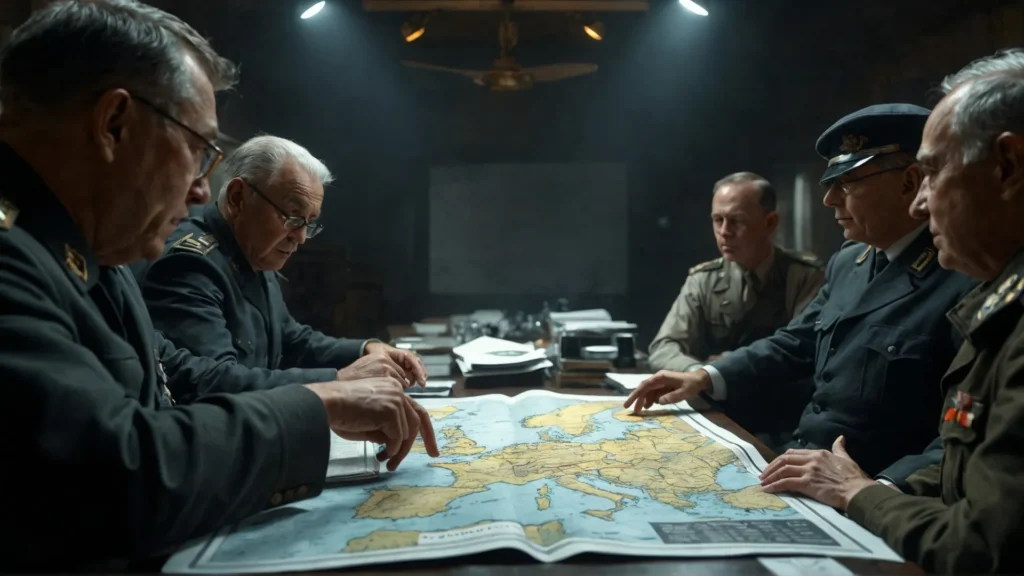
Comprehensive Analysis: The Far-Reaching Impact of the War
Looking at WWII, we see many impacts. Over 400,000 Americans died, a sacrifice to keep freedom. This loss is remembered every year at The National WWII Museum.
The war also changed the world’s politics. It led to new lines on maps and the start of the United Nations. This group was made to stop future wars.
An Era Defined by Conflict: Insights into the Second Global War
After WWII, the world was forever changed. The war’s effects were seen in many areas, like politics and society. The Holocaust, where six million Jews were killed, is a sad reminder of the war’s cruelty.
Looking back, we see how the war’s effects lasted long after it ended. These effects still shape our world today.
| Event | Date | Description |
|---|---|---|
| Operation Barbarossa | June 22, 1941 | German forces invade Soviet Union, marking the largest military operation in history. |
| Pearl Harbor Attack | December 7, 1941 | Triggering U.S. entry into World War II, leading to significant military and civilian mobilization. |
| Battle of Britain | July 10 – October 31, 1940 | German bombers target British cities in a failed attempt to soften the UK for invasion. |
| The Blitz | September 7, 1940 – May 11, 1941 | Extensive bombing campaign over Britain, resulting in heavy civilian casualties and destruction. |
The Aftermath of War: Rebuilding and Retribution
World War II ended, starting a huge task: dealing with its aftermath and a changed world. The war took eighty million lives and destroyed many places. People worked hard to rebuild and punish those who committed crimes.
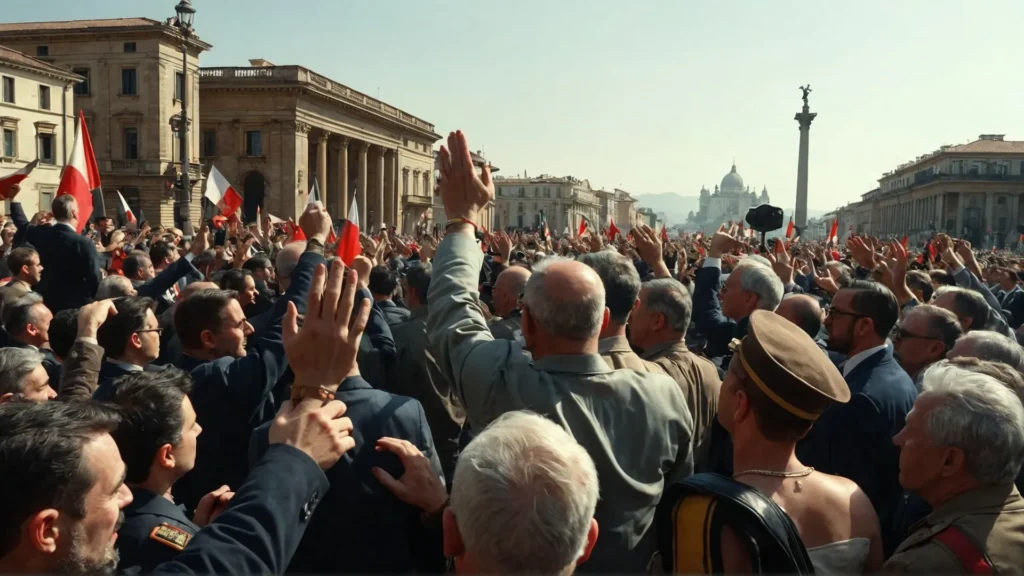
They started big projects to fix damaged areas and brought criminals to justice. This was a time of great change and effort to make things right.
The Formation of the United Nations and the Beginning of the Cold War
After the war, countries knew they had to work together. So, the United Nations was created to stop future wars and bring peace. But, the US and the Soviet Union soon started to disagree, starting the Cold War.
This new era was filled with tension and competition. It led to a race for weapons and divided the world into different areas.
Post-War Trials and Accountability for War Crimes
Even after the war, justice was still a goal. War trials were set up to deal with the crimes done during the war. The Nuremberg Trials were key, holding Nazi leaders accountable and helping create international law.
These trials set a standard for dealing with war crimes in the future. They showed the world how important it is to hold people responsible for their actions.
At the same time, countries like the US helped rebuild through big aid programs. The Marshall Plan gave over $12 billion to Europe. In Japan, the US gave more than $2 billion to help rebuild. This showed the world’s commitment to fixing the damage and preventing future disasters.
FAQ
What triggered the outbreak of World War II in 1939?
World War II started due to many reasons. These include unfinished business from World War I and aggressive actions by the Axis Powers, like Nazi Germany. The invasion of Poland by Germany on September 1, 1939, and the Soviet Union soon after, led to Britain and France declaring war on Germany.
What were the Blitzkrieg tactics, and how did they affect the early years of WWII?
Blitzkrieg was a fast attack strategy used by Nazi Germany. It combined air power, artillery, and ground forces for quick victories. This strategy led to Germany’s fast wins in the early WWII years, including the defeat of France and the occupation of much of Europe.
How did the United States become involved in WWII?
The U.S. started by staying neutral. But Japan’s surprise attack on Pearl Harbor on December 7, 1941, pulled the U.S. into the war. The U.S. then fought against the Axis Powers.
What was the significance of the Battle of Stalingrad and the D-Day Invasion?
The Battle of Stalingrad was a key moment on the Eastern Front. It marked the end of Germany’s push east and the start of the Soviet counterattack. The D-Day Invasion on June 6, 1944, opened the Western Front. It led to the liberation of Western Europe from Nazi control and marked the start of the end for Nazi Germany.
Who were the key leaders of the Allied and Axis Powers during WWII?
The main Allied leaders were Franklin D. Roosevelt (U.S.), Winston Churchill (U.K.), and Joseph Stalin (Soviet Union). The Axis Powers were led by Adolf Hitler (Germany), Benito Mussolini (Italy), and Emperor Hirohito (Japan).
What role did advancements in technology and warfare innovation play during WWII?
New technologies, like tanks and aircraft, changed battle tactics and strategies. The atomic bombs on Hiroshima and Nagasaki were key innovations. They marked the start of the atomic age and helped end the war in the Pacific.
How did World War II impact societies around the world?
WWII deeply affected societies worldwide. It brought disruptions through rationing, propaganda, and total war mobilization. Women entered the workforce in large numbers, and civil rights issues were highlighted. Post-war, societies faced challenges in rebuilding and dealing with war crimes and the Holocaust.
What was the Holocaust, and how did it come to be during WWII?
The Holocaust was the systematic persecution and murder of six million Jews and millions of others by the Nazi regime. It was carried out through concentration camps and mass exterminations. Nazi ideology and dehumanization drove this genocide.
After World War II, how did the world seek to maintain peace and prevent future conflicts?
After WWII, the world aimed to prevent future wars. The United Nations was formed to promote peace and cooperation. The Nuremberg Trials and legal standards were set to hold individuals accountable for war crimes.
How did World War II end, and what were the dates of V-E Day and V-J Day?
WWII ended in Europe on May 8, 1945, with Germany’s surrender. This was Victory in Europe Day (V-E Day). The war in the Pacific ended with Japan’s surrender on September 2, 1945, marked as Victory over Japan Day (V-J Day).
